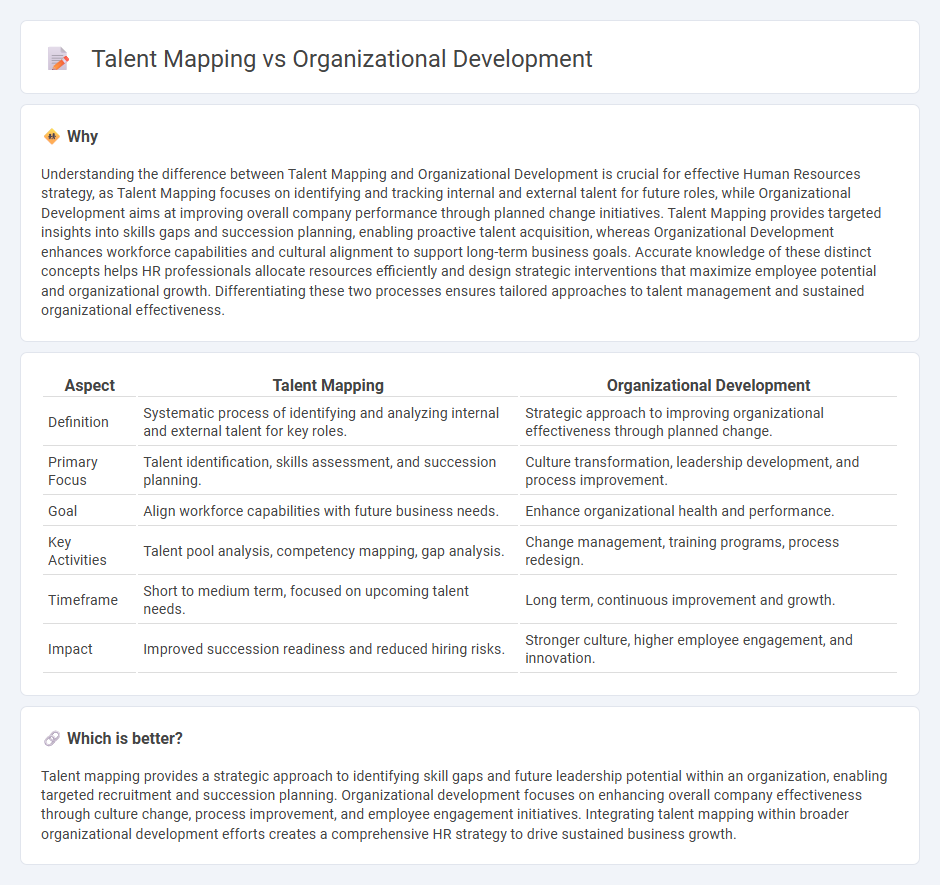
Talent mapping identifies and analyzes the skills and potential of employees to align workforce capabilities with strategic business goals. Organizational development focuses on improving company culture, processes, and structures to enhance overall performance and adaptability. Explore more insights on how these core HR strategies drive sustainable growth.
Why it is important
Understanding the difference between Talent Mapping and Organizational Development is crucial for effective Human Resources strategy, as Talent Mapping focuses on identifying and tracking internal and external talent for future roles, while Organizational Development aims at improving overall company performance through planned change initiatives. Talent Mapping provides targeted insights into skills gaps and succession planning, enabling proactive talent acquisition, whereas Organizational Development enhances workforce capabilities and cultural alignment to support long-term business goals. Accurate knowledge of these distinct concepts helps HR professionals allocate resources efficiently and design strategic interventions that maximize employee potential and organizational growth. Differentiating these two processes ensures tailored approaches to talent management and sustained organizational effectiveness.
Comparison Table
| Aspect | Talent Mapping | Organizational Development |
|---|---|---|
| Definition | Systematic process of identifying and analyzing internal and external talent for key roles. | Strategic approach to improving organizational effectiveness through planned change. |
| Primary Focus | Talent identification, skills assessment, and succession planning. | Culture transformation, leadership development, and process improvement. |
| Goal | Align workforce capabilities with future business needs. | Enhance organizational health and performance. |
| Key Activities | Talent pool analysis, competency mapping, gap analysis. | Change management, training programs, process redesign. |
| Timeframe | Short to medium term, focused on upcoming talent needs. | Long term, continuous improvement and growth. |
| Impact | Improved succession readiness and reduced hiring risks. | Stronger culture, higher employee engagement, and innovation. |
Which is better?
Talent mapping provides a strategic approach to identifying skill gaps and future leadership potential within an organization, enabling targeted recruitment and succession planning. Organizational development focuses on enhancing overall company effectiveness through culture change, process improvement, and employee engagement initiatives. Integrating talent mapping within broader organizational development efforts creates a comprehensive HR strategy to drive sustained business growth.
Connection
Talent mapping identifies the skills, competencies, and potential within the workforce, creating a strategic database for future organizational needs. Organizational development leverages this talent data to design targeted training, succession planning, and culture enhancement initiatives that align employee growth with business goals. The integration of talent mapping with organizational development drives effective workforce planning, improves employee engagement, and enhances overall organizational performance.
Key Terms
**Organizational development:**
Organizational development involves strategic interventions aimed at improving a company's overall effectiveness, culture, and capacity for change through planned initiatives such as team building, leadership development, and process enhancement. It focuses on aligning organizational structures and processes with business goals to drive sustainable growth, employee engagement, and innovation. Explore how organizational development can transform your business performance and workforce dynamics.
Change management
Organizational development centers on comprehensive strategies to enhance company effectiveness through culture, processes, and structure changes, while talent mapping specifically identifies and aligns employee skills with future organizational needs. Change management plays a crucial role in both by ensuring smooth transitions and minimizing resistance during implementation. Explore more about how these approaches integrate to drive successful organizational transformation.
Organizational culture
Organizational development enhances company culture by implementing strategic initiatives that foster continuous growth, employee engagement, and adaptive change management. Talent mapping identifies key skill sets aligned with cultural values to ensure the right talent is positioned for long-term success within the organization. Explore how integrating organizational development with talent mapping can transform your workplace culture.
Source and External Links
What Is Organizational Development? A Complete Guide - AIHR - Organizational development involves planned interventions to support growth, innovation, and cultural transformation through stages like entering, diagnosing, intervening, evaluating, and termination.
What is Organizational Development? - IBM - Organizational development is a systematic process to change strategies, procedures, and culture to improve performance and effectiveness, often involving research-driven interventions.
What Is Organization Development? - TD - Organization development focuses on improving organizational capability by aligning strategy, structure, people, and processes, using a holistic and strategic approach.
 dowidth.com
dowidth.com